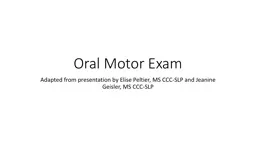

What is an Oral Motor Exam Determine the structural and functional adequacy of the oral mechanisms A variety of medical professionals may complete dentists doctors and speech language pathologists ID: 914815
Download Presentation The PPT/PDF document "Oral Motor Exam Adapted from presentati..." is the property of its rightful owner. Permission is granted to download and print the materials on this web site for personal, non-commercial use only, and to display it on your personal computer provided you do not modify the materials and that you retain all copyright notices contained in the materials. By downloading content from our website, you accept the terms of this agreement.
Slide1
Oral Motor Exam
Adapted from presentation by Elise Peltier, MS CCC-SLP and Jeanine Geisler, MS CCC-SLP
Slide2What is an Oral Motor Exam
Determine the structural and functional adequacy of the oral mechanisms
A variety of medical professionals may complete dentists, doctors and speech language pathologists.
Slide3Alternative terminology
Oral Motor Exam
Oral Peripheral Exam
Oral Mechanism Exam (Oral
Mech
)
Speech Mechanism
Slide4Why do an Oral Motor Exam ?
Stroke ( CVA)
Feeding and Swallowing
Articulation Disorder
Motor Speech Disorder
Dysarthria
Apraxia
Slide5Tools
Gloves
Tongue Depressor
Pen Light
Small hand held mirror
Watch ( stop watch)
or clock
Slide6What structures do we look at ?
Face
Lips
Teeth
Tongue
Jaw ( mandible)
Hard/Soft Palate
Cheeks
Slide7How do we illicit desired results
Adult clients
Give direct verbal instructions
Model
Slide8Target: Facial Symmetry
Have subject look straight at you
Are facial features symmetrical?
Slide9Target: Tongue
Elicitation
Stick straight out, left then right, left right quickly, elevation, retraction, protrusion and lateral movement against resistance ( cheek or tongue blade)
Observations
Look for symmetry and range of motion,
size and evidence of
fasiculations
.
https://www.youtube.com/watch?v=xuwdvBXcr30
Assess ability to exert force against resistance
Assess coordination of fast movements
Slide10Target: Lips
Elicitation
Smile
Pucker
Open
Close Tight
Puff up cheeks, hold against resistance
Observations- Look for symmetrical movements, extent of movements, ability to close completely and hold against resistance
Slide11Target: Oral Cavity and Velum
Elicitation
Open Wide
Say “ah” or “E-E-E-”
Observation
Look at conditions of teeth, any dentures or partials?
Watch for extent and symmetry of velar elevation and pharyngeal constriction
Slide12Target: Voice/Airway Protection
Elicitation
Maximum phonation duration
S:Z ratio, pitch glides
Volitional cough and
Throat clearing
Observations
Listen for intensity, pitch and quality
Listen for breathy, horas/harsh, strained, wet/
gurgly
Listen for hyper or
hyponasality
Slide13Special considerations for adults
Hearing loss or auditory comprehension
- check for hearing aids, write instructions, model
Adults with Apraxia
Blow a kiss, smile
Give a spoon or straw
Slide14Assessing for Apraxia of Speech
Diadochokinetic
Rate
- Repeat “
papapapa
”
- Repeat “
tatatata
”
- Repeat “
kakaka
”
Alternate Motion Rate
- Repeat “
pataka
”
Nonspeech
tasks (assess for oral apraxia)
Slide15How can we describe/ measure
We can describe muscle and function and movement using
STARRS
MUSCLE
S
TRENGTH
MUSCLE
T
ONE
A
CCURACY OF MOVEMENT
R
ANGE OF MOVEMENT
S
PEED OF MOVEMENT
S
TEADINESS OF MOVEMENT
Slide16STARRS Characteristics
One way to describe muscle function and movement
Rating Scale from 0-4 with
0 indicating normal function
1 mild impairment ( ~25% or less impaired)
2 moderate ( ~50% or more is impaired )
3 severe (~ 75% or more is impaired)
4 indicating profound deficits ( unable to perform)
Slide17Muscle S
trength
Descriptive terms: weakness, asymmetry, atrophy
Potential causes- Bell’s Palsy, facial Palsy, lower motor neuron lesion, upper motor neuron lesion, tumor, TBI, Stroke CVA
Slide18Muscle T
one
Look for Hypotonic
Example- Tongue or lips may appear thickened and have little or no movement
Common causes- Cerebral Palsy, Down Syndrome
Hypertonic
Increased activity and resistance
Common causes Bells palsy, facial palsy symptoms
Slide19Accuracy of movement
Descriptive terms: Uncoordinated or groping
Potential causes :Apraxia- problem assembling the appropriate sequence of movements often results from unilateral left left hemisphere lesion ( Darley, Aronson, and Brown 1975, 1969)
Slide20Range of Movement
Descriptive terms: reduced or decreased
Hypokinesia
- decreased body movement
Excessive range is not common in neurological disease but decreased range is more common and may occur in the context of slow, normal or excessively rapid rate
Example: Hypokinetic dysarthria- decreased range of motion and sometimes excessive rate
( Duffy 2005)
Slide21Speed of Movement
Descriptive terms: Slow
Bradykinesia- slowness of movement
Potential causes; neuroanatomical area or system involvement ( upper motor neuron system, lower motor neuron system, cerebellum, extrapyramidal system or combination
Dysarthria – a group of speech disorders resulting in weakness, slowness, incoordination due to damage central or peripheral nervous system or both
Term dysarthria encompasses coexisting neurogenic disorders of several or all of the basic processes of speech: respiration, phonation, resonance, articulation and prosody ( Darley, 1969)
Slide22Steadiness of Movement
Tremor- unintentional, rhythmic muscle movement involving to and fro movements
Neurological causes include Multiple Sclerosis, stroke, traumatic brain injury, or some medications or alcohol use or withdrawal
fasciculations
- involuntary muscle contraction and relaxation which may be visible under the skin
Causes -lower motor neuron lesions
ALS-
Spasms ( lingual dystonia) involuntary muscle contractions
Possible causes Cerebral Palsy, MS, nerve damage from a stroke
Slide23